After my recent less than satisfactory experience with gummy rye bread, I returned to an old, reliable favorite of mine - Hansjoakim's 70% Rye Bread.
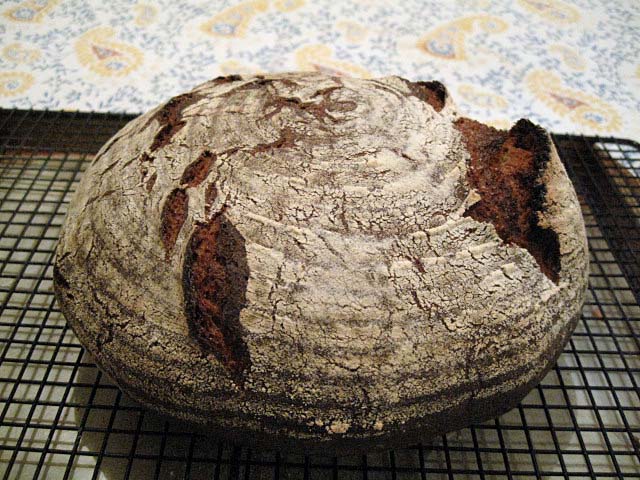
Total formula | Amount | Baker's % |
Medium rye flour | 436 g | 70 |
First clear flour | 187 g | 30 |
Water | 467 g | 75 |
Salt | 11 g | 1.8 |
Rye sour final build | Amount | Baker's % |
Medium rye flour | 218 g | 100 |
Water | 218 g | 100 |
Ripe rye sour | 11 g | 5 |
Final dough | Amount | Baker's % |
Medium rye flour | 218 g | 54 |
First clear flour | 187 g | 46 |
Water | 249 g | 61.5 |
Salt | 11 g | 2.7 |
Rye sour (all of the above) | 447 g | 110 |
Note: 35% of the total flour is from the rye sour. | ||
Procedures:
The day before baking, mix the final rye sour build. This should ferment at room temperature for 14-16 hours.
I used a KitchenAid stand mixer, but these procedures could be done by “hand.” Mix all the ingredients in the final dough in a large bowl. If using a stand mixer, mix for 3 minutes with the paddle at Speed 1. Switch to the dough hook and mix for 5-6 minutes more at Speed 2. The dough at this point is a thick paste with little strength (gluten development providing extensibility and elasticity). Optionally, after mixing, you can knead briefly on a floured board with well-floured or wet hands.
Transfer the dough to an oiled bowl, cover it tightly, and ferment for 1 hour.
Transfer the dough to a floured board and pre-shape it into a single round. Cover with plasti-crap or a damp kitchen towel and rest for 5 minutes.
Shape the dough into a boule and transfer to a well-floured brotform or banneton, seam-side down.
Cover the boule with plasti-crap or a damp towel and proof for two hours. (My loaf was fully proofed in 1 hr and 30 min.)
One hour before baking, pre-heat the oven to 250C/480F with a baking stone and your steaming method of choice in place.
When ready to bake the bread, transfer the boule to a peel. Transfer the boule to the baking stone. Steam the oven. Turn the temperature down to 460ºF.
After 10 minutes, remove your source of steam from the oven.
After 15 minutes, turn the oven down to 225C/440F.
Bake another 40-45 minutes. Monitor the loaf color, and, if it is darkening too quickly, turn the oven temperature down further. It would be well within the rye baking tradition to do this planfully in steps, ending up as low as 205C/400F for the last 10-15 minutes.
The loaf is done when the crust feels firm, it gives a “hollow sound” when the bottom is thumped and the internal temperature is 205F or greater.
When the loaf is done, turn off the oven, but leave the loaf in it with the door ajar for an additional 10 minutes.
Transfer the loaf to a cooling rack and cool thoroughly before slicing. It will be best to leave it 24 hours, loosely wrapped in linen, before slicing.
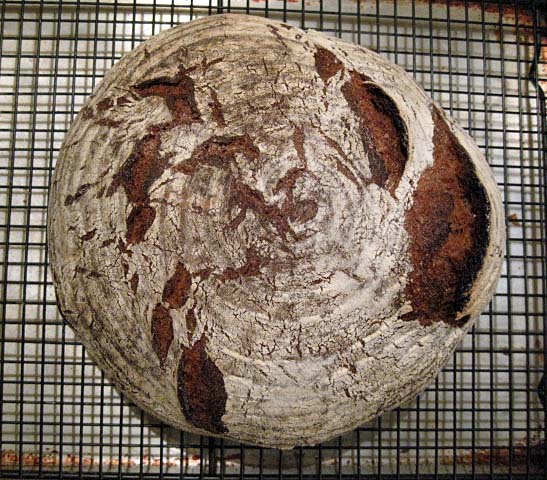
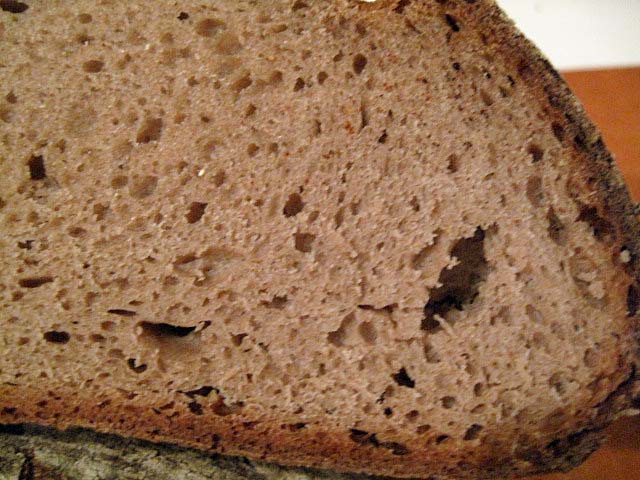
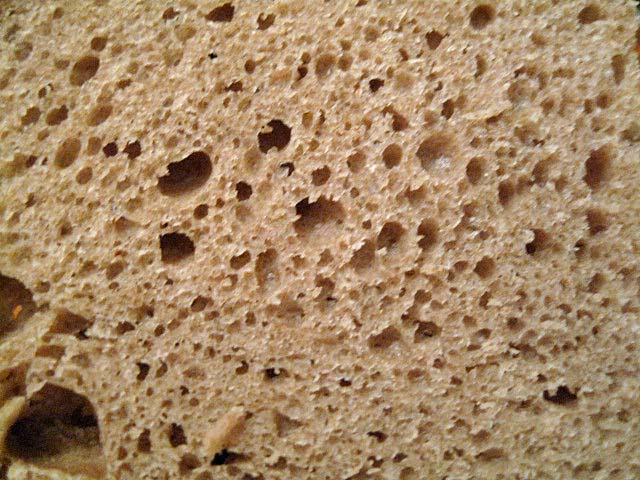
This is a delicious bread with a mild to moderate sourdough tang and earthy rye flavor. The crumb is tender and moist, but not at all gummy. It's my idea of a delicious high-percentage rye bread. It will be perfect for tomorrow's breakfast with cold-smoked salmon and for dinner with split pea soup.
I also baked a couple loaves of the Tartine Basic Country Bread, another of my favorites.
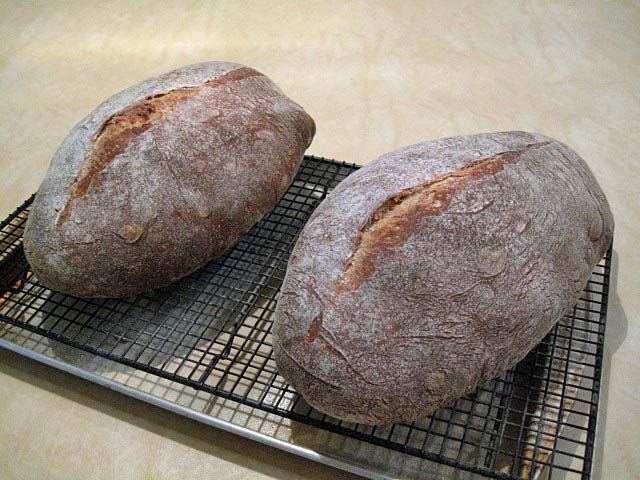
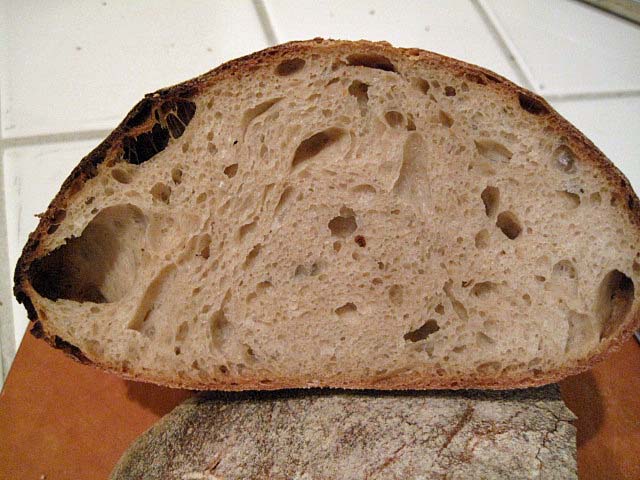
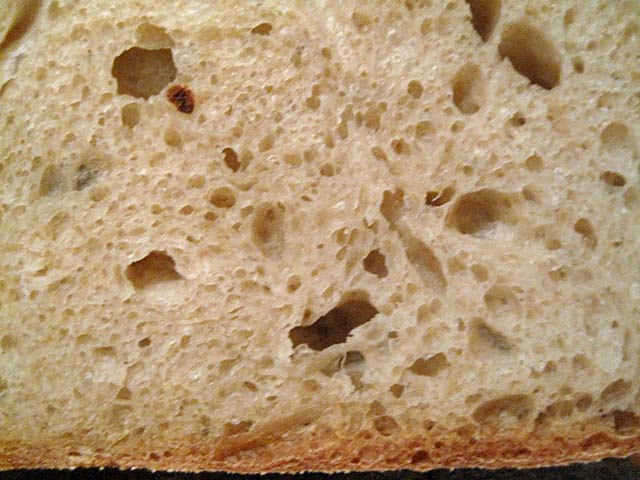
This time, I did not retard the loaves overnight. I don't recall if I've done this before, but I really enjoyed the result. Tasted two hours out of the oven, still a little warm, the flavor was spectacular. It was very mildly sour with a sweet, complex wheaty flavor. Either with or without retardation, this is a delicious bread.
David
Submitted to YeastSpotting
- dmsnyder's Blog
- Log in or register to post comments
They are all nice David but especially the rye. For such a high percentage it has very nice crumb structure.
Eric
David
The moist looking, even celled crumb on the 70% rye bread looks excellent David, and my idea as well of the kind of high ratio rye I enjoy most. Your Tartine Country Bread looks very nice done as a batard, a shape I prefer for sandwiches over a boule. I've done the Tartine breads several times without the overnight retard and have always thought they tasted as good and in some cases better than the overnight versions. Both the crumb and crust of your loaves look delicious! What type of flour did you use for the loaf ? The crumb colour in the first photo reminds me of what CM's Artisan Malted looked like when I used it a few months back.
Franko
I used KAF AP and CM's Fine WW flours for the Tartine BCB.
David
Hi David,
24 hours is probably seeming like an age to you.
The rye bread looks wonderful, and your Tartine loaves are tempting as ever too.
Best wishes
Andy
I have concluded that the purpose of wrapping these rye breads in baker's linen while they rest is to hide them from the baker, thus diminishing the temptation to slice them prematurely.
David
Those look brilliant, David! I particularly like the dark crust on that rye of yours - especially the nearly charred bits close to the cracks... And a lovely crumb as well, very impressive for a 70% rye!
What can one do with such an outstanding recipe?
David
Hello David,
It looks like the rye rose nice and high, just like your Tartine bread, and both breads have such lovely crumb :^)
I wanted to please ask, do you aim for a particular dough temperature when you are making your rye?
- breadsong
I must confess I do not monitor dough temperature while mixing. I go for a target consistancy and gluten development. I know I should shoot for the DDT, but, since I am usually staying home and can monitor fermentation by sight and touch frequently, I figure it's not a big deal.
I have been paying more attention to fermentation and proofing temperatures, though. I've ordered one of the proofing boxes about which Sylvia's been telling us.
David
Thanks David - and hope you enjoy working with your new proofer.
:^) breadsong